Honor Award
The Brochstein Pavilion at Rice University
Houston USA
The Office of James Burnett, Houston USA
Client: Rice University
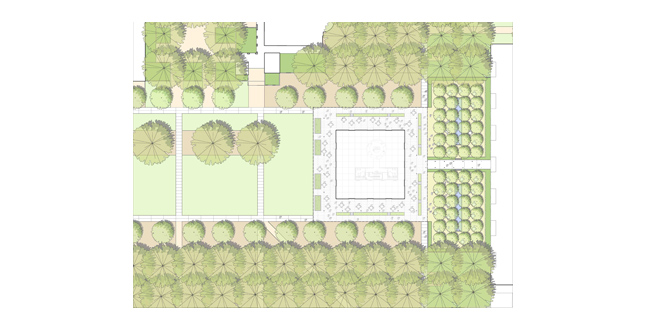
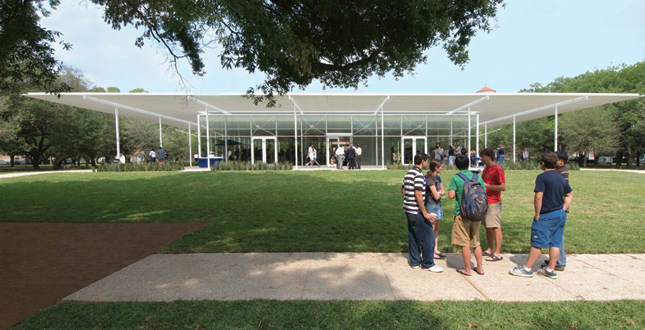 Close Me!
Close Me!The west elevation of the pavilion. Designed to respect the original concept of the Central Quadrangle, the new intervention employs a simple system of paths, lighting and planting to unify the disparate spaces.
Download Hi-Res ImagePhoto: Paul Hester
Photo 2 of 15
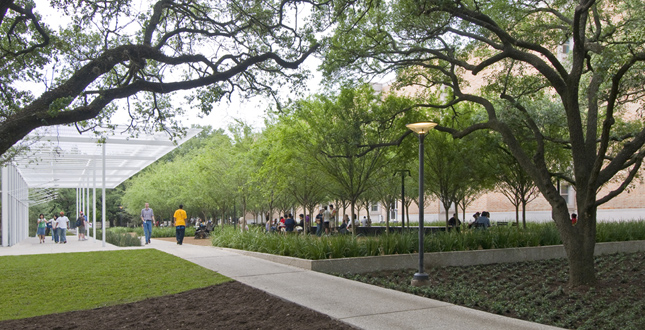 Close Me!
Close Me!A bosque of Allee lacebark elms organizes the space between the pavilion and creates a new entry to the Fondren Library. This garden and pavilion has become the new "Heart of the Campus" at Rice.
Download Hi-Res ImagePhoto: Paul Hester
Photo 3 of 15
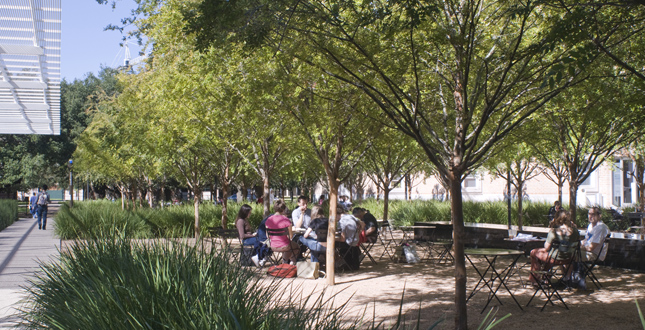 Close Me!
Close Me!The garden courts provide shady respite for students and visitors to gather between classes. WiFi, movable chairs, nearby food and beverages in the pavilion support the use of this outdoor commons.
Download Hi-Res ImagePhoto: Paul Hester
Photo 4 of 15
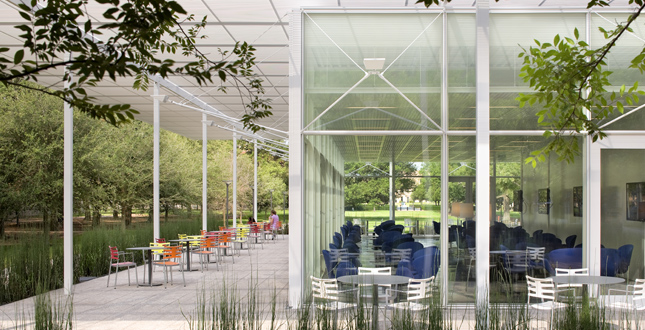 Close Me!
Close Me!A simple plaza of scored and sandblasted concrete extends the geometry of the building into the landscape. The elms and oaks extend the column grid of the building into the landscape.
Download Hi-Res ImagePhoto: Scott Frances
Photo 5 of 15
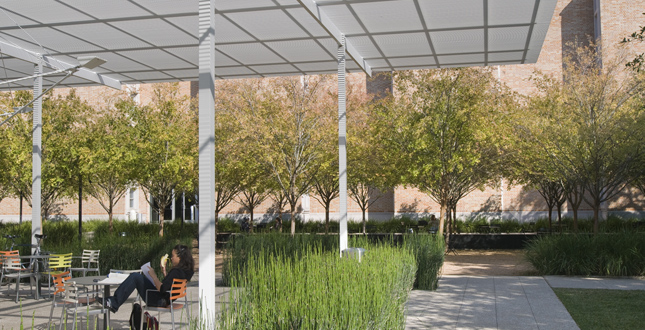 Close Me!
Close Me!The fall color of the elms provides a wonderful contrast with the lustrous green of the iris and horsetail. The horsetail provides a buffer between the "porch" and the adjacent campus walks.
Download Hi-Res ImagePhoto: Paul Hester
Photo 6 of 15
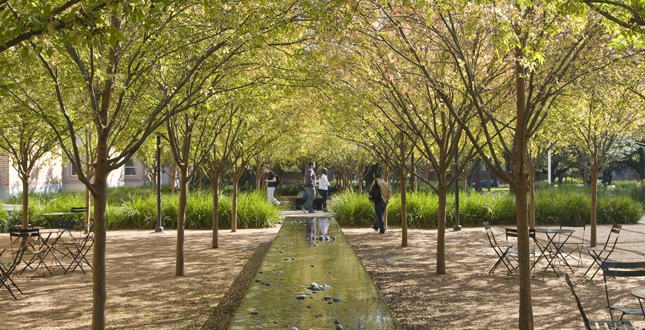 Close Me!
Close Me!The water trays provide a calming and continuous sound in the garden. They are more interactive than we had envisioned as people enjoy moving the stones within the basin to expose the clusters.
Download Hi-Res ImagePhoto: Paul Hester
Photo 7 of 15
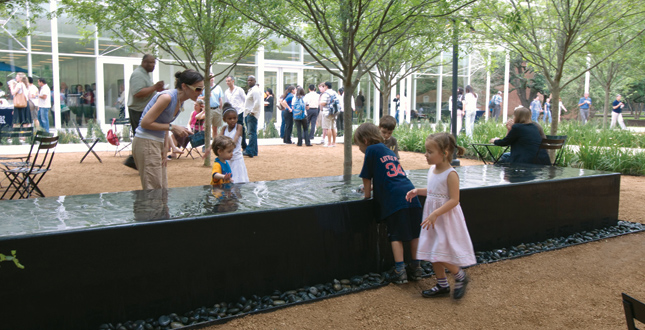 Close Me!
Close Me!The height and proportion of the basins invite children and adults to interact with the water, moving stones and touching the water as it sheets across the basins.
Download Hi-Res ImagePhoto: Paul Hester
Photo 8 of 15
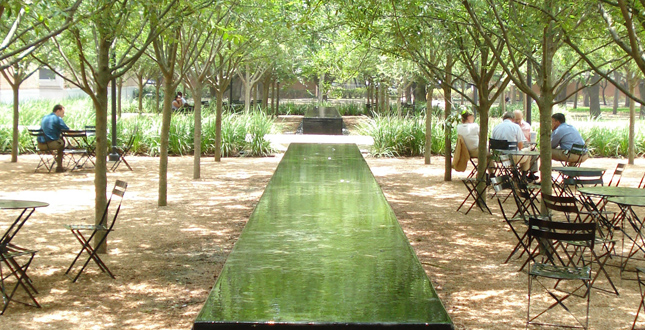 Close Me!
Close Me!The surface of the basin spectacularly mirrors the sky and the canopies of the elms.
Download Hi-Res ImagePhoto: The Office of James Burnett
Photo 9 of 15
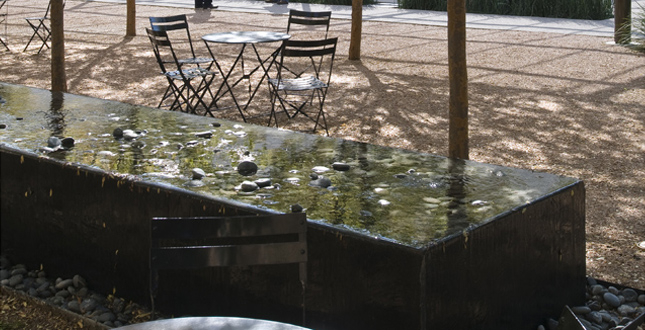 Close Me!
Close Me!Protected from the intense Houston sun by a continuous canopy of Allee elms, visitors rearrange the bistro chairs and tables to suit their changing needs.
Download Hi-Res ImagePhoto: Paul Hester
Photo 10 of 15
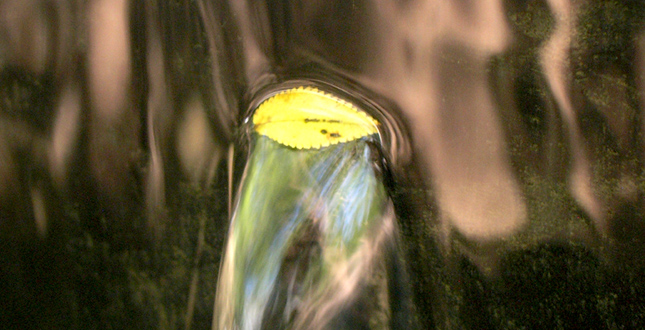 Close Me!
Close Me!Elm leaves trapped on the membrane create subtle variations across the basin.
Download Hi-Res ImagePhoto: The Office of James Burnett
Photo 11 of 15
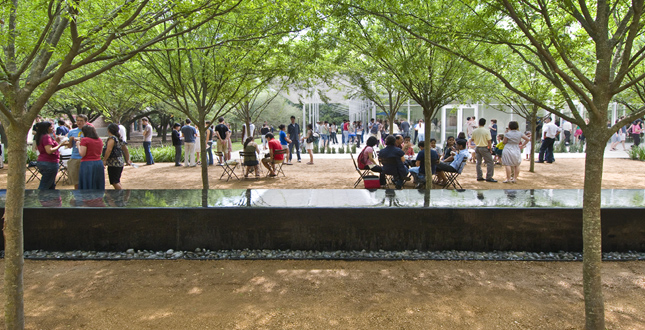 Close Me!
Close Me!The new "heart of the campus" has become a popular location for receptions, parties and celebrations at the campus.
Download Hi-Res ImagePhoto: Paul Hester
Photo 12 of 15
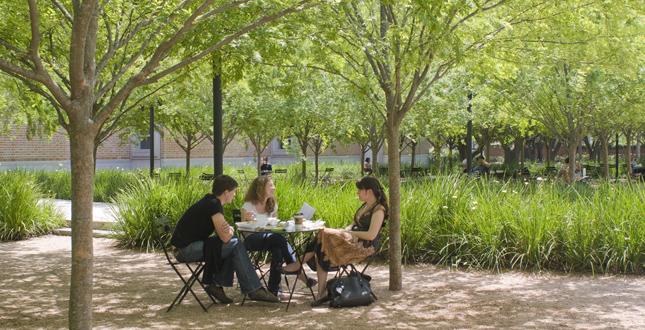 Close Me!
Close Me!Lured by the garden's comfortable microclimates, students frequently meet to work, study and interact.
Download Hi-Res ImagePhoto: Paul Hester
Photo 13 of 15
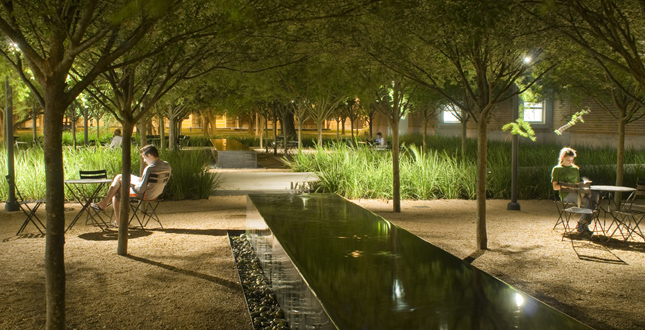 Close Me!
Close Me!Site lighting provides a sense of security that encourages students to study and socialize at all hours. The water trays provide drama and depth to the garden at night.
Download Hi-Res ImagePhoto: Paul Hester
Photo 14 of 15
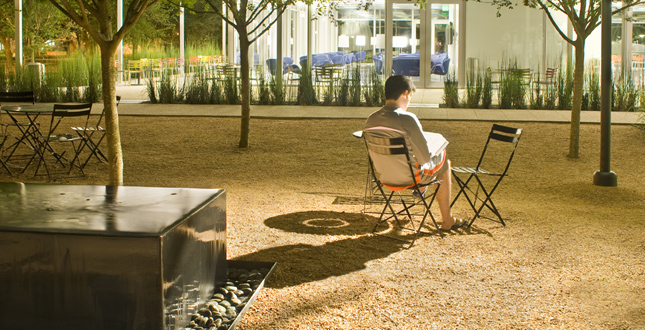 Close Me!
Close Me!Students can experience the garden at all hours of the night.
Download Hi-Res ImagePhoto: Paul Hester
Photo 15 of 15
Project Statement
Conceived as a landmark destination for Rice University's campus, the Brochstein Pavilion demonstrates the ability of landscape architecture to foster social interaction and improve the human condition. A study in restraint and the purity of form, the Brochstein Pavilion creates a powerful spatial framework that has transformed an unstructured, underutilized quadrangle into the center of student activity on campus.
Project Narrative
—2010 Professional Awards Jury
Founded in 1912, the Rice University campus is noted for its neo-Byzantine architecture, mature southern live aaks and a classical campus plan that emphasizes long, formal axes. In 2005 the Board of Trustees approved "A Vision for the Second Century," a strategic plan that recognizes the importance of placemaking in campus culture. The Vision acknowledges the need to "provide the spaces and facilities that will cultivate greater dynamism and vibrancy on the campus and foster [a] sense of community." The vision identified the need for a new social hub at the Central Quadrangle and following a generous donation from a Houston philanthropist, the university engaged a design team to implement this goal.
The university challenged the team to develop a scheme that responded to the constraints of the Central Quadrangle. Originally the primary east–west axis of the campus, the quadrangle was disrupted by the addition of the Fondren Library in 1940. Waiving the stringent architectural guidelines that typically apply to new construction on campus, the designers were charged with the creation of an iconic campus landmark that would offer flexible, nonprogrammed space that would become the intellectual crossroads of the campus.
Meticulously detailed and unpretentious, the transparency of the 6,000-square-foot glass, steel and aluminum pavilion offers a sublime contrast to the adjacent buildings. To complement the modesty of the building, the landscape architect surrounded the structure with a 10,000-square-foot concrete plaza scored and sandblasted in a simple geometric pattern that references the plan of the building. Linear bands of horsetail reed define the edge of the outdoor dining and separate the adjacent pedestrian paths.
Interventions to the area of the Central Quadrangle to the west were limited to those that reinforced the existing framework of the space but the newly created interstitial space between the library and the pavilion required a more complex approach. Responding to the grid of the building, a bosque of 48 specimen allee lacebark elms rise from a plane of decomposed granite and provides an organizational framework that humanizes the scale of the space. A generous concrete walk connecting the library and the pavilion bisects the grove into garden rooms defined by plantings of African iris. Long black concrete fountains filled with beach stone occupy the center of each space, filling the garden with the murmur of running water and reflecting the filtered light through the canopy. Movable furniture and subtle site lighting allow impromptu gatherings of visitors to enjoy the oasis created by the dense shade and running water.
Respecting the lightness of the building, the landscape architect made minimal interventions elsewhere. New concrete walks and a row of specimen live oaks reinforce the existing spatial framework of the quadrangle. Although the floodplain requirements necessitated a finish floor elevation considerably higher than existing grade, the architects favored a solution that would not isolate the building on a dramatic plinth. Carefully considering the existing trees, the landscape architect subtly manipulated the grading of the approach walks so that building feathers into the landscape and overcomes the flatness of the campus
Working closely with the architect, the landscape architect developed a scheme that gracefully harmonizes the building with the landscape, knitting together many disparate elements on a challenging site and strengthening the existing framework of the campus.
By creating a garden that promotes human interaction and offers respite day or night, the landscape architect has redefined the way that generations of students will view public space.
Project Resources
Project Team
James D. Burnett, FASLA, Design Principal
Chip Trageser, ASLA, Managing Principal
Andrew Albers, Project Manager
Architect
Thomas Phifer & Partners
Civil Engineering
Walter P. Moore
Geotechnical Engineering
Ulrich Engineers
MEP Engineering
Altieri Sebor Wieber
Structural Engineering
Haynes Whaley Associates
Landscape Contractor
Dan Sugulas, B&D Contractors, Inc.
Specifications
Construction Specifications
Lighting Design
Fisher Marantz Stone
Contractor
Linbeck Group






